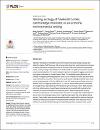Nesting ecology of hawksbill turtles, Eretmochelys imbricata, in an extreme environmental setting
| المؤلف | Chatting, Mark |
| المؤلف | Smyth, David |
| المؤلف | Al-Maslamani, Ibrahim |
| المؤلف | Obbard, Jeffrey |
| المؤلف | Al-Ansi, Mehsin |
| المؤلف | Hamza, Shafeeq |
| المؤلف | Al-Mohanady, Salman Fahad |
| المؤلف | Al-Kuwari, Ali Jassim |
| المؤلف | Marshall, Christopher D. |
| تاريخ الإتاحة | 2019-04-18T09:17:48Z |
| تاريخ النشر | 2018-09-07 |
| اسم المنشور | PLoS ONE |
| المعرّف | http://dx.doi.org/10.1371/journal.pone.0203257 |
| الاقتباس | Chatting M, Smyth D, Al-Maslamani I, Obbard J, Al-Ansi M, Hamza S, et al. (2018) Nesting ecology of hawksbill turtles, Eretmochelys imbricata, in an extreme environmental setting. PLoS ONE 13(9): e0203257. https://doi.org/ 10.1371/journal.pone.0203257 |
| الملخص | Relatively few details of hawksbill turtle (Eretmochelys imbricata) nesting ecology exist within the Arabian Gulf. Moreover, little is known about how their nesting dynamics compare to nesting populations throughout the rest of the world. Due to the extreme environmental setting, nesting ecology of hawksbills in the Arabian Gulf is of significant interest to researchers and conservationists. The current research reports on a long-term tagging and monitoring program undertaken at Fuwairit beach, Qatar. To investigate nesting behavior, site surveys and tagging were employed from 2010 to 2016. Presence of nests and clutch sizes were confirmed by excavation. Over the entire study period, nesting hawksbills had a mean curved carapace length of 70.8 cm (SD±2.8). A total 187 nests were confirmed, which contained a mean 78.9 eggs per clutch (SD±17.1), over an annual nesting season that lasted an average of 52.2 days (SD±6.3) from the start of April to the start of June. Meta-analysis with other global regions showed these characteristics to be significantly reduced when compared to nesting hawksbills from other populations. Meteorological data analysis showed air temperatures in the Arabian Gulf to increase on average 13.2°C (SD±0.26) from start to the end of nesting annually, which is significantly greater than other global nesting regions. Their smaller body size and reduced fecundity coupled with the extreme change in ambient air temperatures support the hypothesis that hawksbills in the region are more at risk than the already critically endangered hawksbill populations elsewhere in the world. |
| راعي المشروع | This study was funded and the work was approved for publication by Qatar Petroleum. Author Christopher D Marshall was supported by grant number5-642-1-110from the Qatar National Research Fund. |
| اللغة | en |
| الناشر | Public Library of Science |
| الموضوع | Qatar hawksbill turtle |
| النوع | Article |
| ESSN | 1932-6203 |
الملفات في هذه التسجيلة
هذه التسجيلة تظهر في المجموعات التالية
-
مجموعة العلوم البحرية [214 items ]


